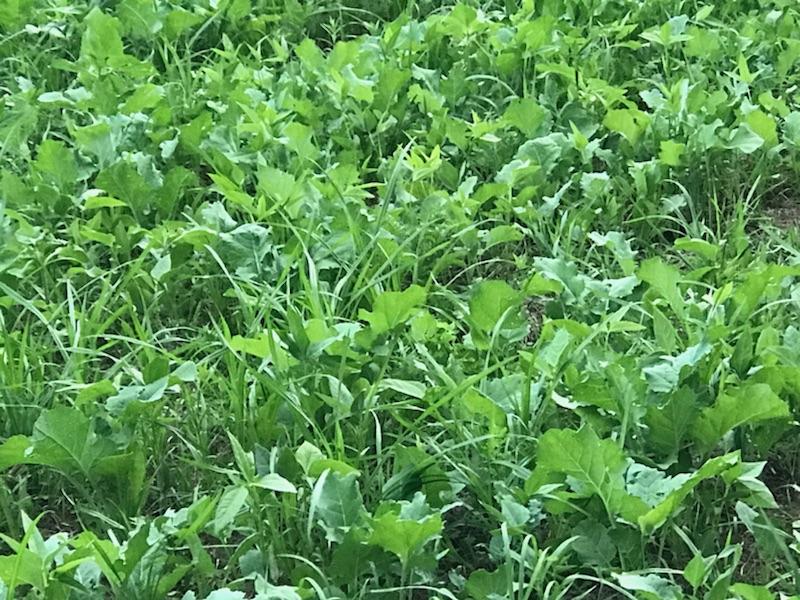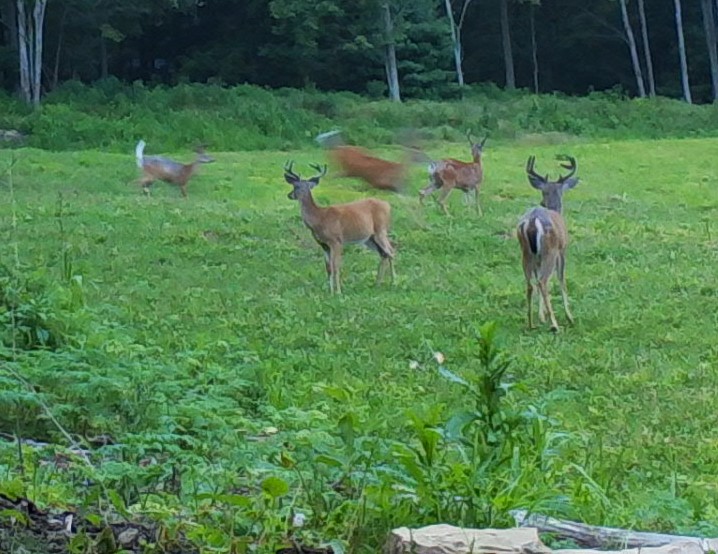What is the Best Fall Food Plot for Deer in PA and NY?
What is the Best Plant to grow for Deer in Fall?
The best choices for fall food plots in tough PA mountain soils are as follows:
- Brassicas – radish, kale, collards, turnips, rape, hybrids
- Small Grains – oats, wheat, winter rye
- Clovers – ladino, medium red, balansa, etc.
- Winter Peas – austrian winter peas
- Chicory
- Hairy Vetch
These seeds can be planted in a mix all together or in individual sections of a food plot. Brassicas and oats will usually die out over winter, but wheat, rye, clover, vetch and peas will provide forage through the winter and come up again in the spring, lasting well into the summer.

When to Plant Fall Food Plots
Now that we are in a severe drought and many food plots have failed, we are anxious to replant them for fall to attract and feed deer. But, don’t be in too much of a hurry. The plants listed above like to have cooler soil temps and need plenty of moisture to germinate and grow. As fall develops, we get cooler nights and shorter days, plus we often get more rain this time of year. I like to plant around Labor Day and plant cover crop cocktails with a mix of these plants. I also like to use a seed drill to get the seeds buried out of reach of the hot sun and birds and get down to the soil moisture. If you can choose your planting time, wait until there is a good bit of rain in the forecast.
How Big Should a Food Plot be for Deer?
I spoke to a landowner the other day who asked me what to plant in his two food plots – a quarter acre each. I can tell you that this small an area will be tough to keep in forage especially if there is little agriculture in the vicinity.
A food plot needs to be big enough to withstand browse pressure by the deer using them. If you have the best food in the range around you, all the deer in that home range will feed there. I have counted as many as 50 deer feeding on a 5 acre plot I have in Central PA. That many deer will wipe out your plantings in short order.
In this case, the food plots should be doubled in size to about ten acres. I once worked on a property that had ten acres of clover planted. The exclusion cages showed that the deer in the area mowed the clover down like lawn mowers despite the large area planted.
So, the answer is – it depends on deer population, availability of other browse and forage and the amount of agricultural forage nearby, such as alfalfa. If you have a small area, then perennials (clover/chicory) and fall planted cereal grains are the only plants that will work.
Food plots are a supplement to native browse and forage in the forest. Deer feed on hundreds of plants found in forest openings as well as tree leaves, buds, fruits and leaves of shrubs. The problem is, most forests have been overbrowsed and are so full of invasive plants that deer don’t eat, there is very little for deer to eat there. When fire and plenty of fruiting shrubs and trees were abundant in the forest, the land could support a lot of deer. Today, we must regenerate forests, reduce native and foreign invasive plants and create forage plots that can supplement the lack of forage in the forest.
How Many Deer Can a Food Plot Feed?
The amount of forage a food plot can produce depends on the plants, soil and climate. A fall planting of brassicas done right can create several tons of forage per acre. My favorite, t-raptor, properly planted and fertilized will produce 5 tons of forage per acre. Grown in the fall, these plants can feed deer when it counts for hunters.
I consider brassicas a cover crop used to build soil and an ice cream plant that has a short window of growth. Therefor, i don’t recommend them as a stand-alone planting. I often visit land in the spring where the owner planted turnips last fall, only to find rotten turnips and wilted plants the deer never ate. A cold-hardy cereal must be added to a brassica plot.
A deer, generally eats about 6% of its body weight in green forage each day. So a 150lb deer needs 9 lbs of forage. over the 90 days that brassica produces forage, a deer will eat 800 lbs of the greens. So, one acre can produce 10,000 lbs of greens, assuming they don’t get demolished. Therefor, an acre of brassicas can feed 12 deer for those 90 days, assuming that they eat only there, which they don’t. Not that impressive is it? What are the deer doing the rest of the year? Well, they will need woody browse, acorns and buds through the winter as well as to dig down through the snow and get some greens such as winter wheat and peas. Native ground greens and roots can be dug up as well.

You can see that planting a variety of plants that are palatable and available at different times during the lean months of winter is key to keep deer around during hunting season. Your 12 deer will need another 100 acres of young forest, oaks for mast, and winter food plots to get them through the rest of winter well fed. So, another acre of small grains and peas would be necessary. Plus some prescribed fire and Timber Stand Improvement harvesting.
A square mile or 640 acres could easily hold a dozen deer per 100 acres or about 70 animals, if it had 2 or 3 acres of forage plots per 100 acres plus forest management. Young forest management and population control are key as deer must have browse and a wide variety of plants and different time of the year. If the tree leaves are out of reach, they are useless to deer and even oaks only produce food for several weeks. Leaves of trees and plants in summer and mast in fall along with buds and new growth of trees and shrubs in winter is what feeds deer. Food plots alone do not. If there is nothing in the forest for deer to eat, they will chew your food plots down to the dirt and wipe out anything you plant before it can produce any real tonnage of forage. In winter, deer switch to browse. If you have a palatable plant in your plots, they will feed there but very little. They are looking for high energy foods – nuts, grains, buds, new growth of shrubs and trees.
Using good forest management can turn a biological desert of mature hardwoods with no understory into a continuous food plot. Common forest plants like blackberry, greenbriar, dogwood and many other native shrubs, roots and buds are what fed deer for millennia before there was farming.
Poor forest management, lack of fire, invasive species and overpopulation of deer have wiped out much of the native foods so that the forest cannot maintain a good population of these animals. Food plots are a great supplement to help support and build a herd of deer. Therefor, they are the keystone to creating great deer habitat.
How to Tell if You Have Enough Food Plots
If you can plant a crop and have it survive to maturity, you have plenty of food planted. If you plant it and it seems that you have a total failure, you probably don’t have enough food on the local range. The best way to tell if its deer wiping out your food plot is to use exclusion cages to compare the growth of plants inside to those outside. If the forage looks a little beat up outside the cages while looking lush inside, you have a good planting that is being utilized by deer but not wiped out. That”s the right amount. If deer are eating your plots down to the dirt before winter sets in and they are feeding on low quality food such as beech stems and eat the greenbriar down to a few inches above the ground, you have too many deer for the range to support. You can then either reduce deer numbers through hunting or add more food plots and young forest cover. Best to do both so the deer don’t damage the new forest plants before they can get started and be able to withstand browse pressure.
What is the Best Food Plot for Deer in the Fall?
The best food plot is going to be brassica blends. Use different varieties that mature and varying lengths of time. Add to that some clover, such as crimson – an annual clover that will be palatable through to the spring and early summer. In the same plot, one can add winter wheat at a lower that normal rate. If you want to have a clover plot there, add both a ladino and red clover. The other plants will fizzle out and the clovers will flourish the next year.
In another spot, plant cereal grains like oats, wheat and winter rye. These can be mixed with some winter peas. Winter peas are palatable all winter through the following spring.
All of the above will feed deer in the critical winter months and be the first plants to green up in spring, when deer need plenty of protein for fawn growth, shedding and adding a new summer coat, growing antlers and making lots of good milk for the young ones. Focusing on fall/winter plants for food plots will do the most to help supplement deer when natural food is scarce. There should be plenty of food in summer as long as there are forest openings and disturbance through logging and prescribed fire.
Check out my Youtube Channel and other social media here: https://linktr.ee/stevechilcote
Become a Food Plot Expert by taking my comprehensive food plot course: Steve’s Course
